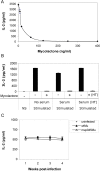Mycolactone diffuses from Mycobacterium ulcerans-infected tissues and targets mononuclear cells in peripheral blood and lymphoid organs
- PMID: 18941518
- PMCID: PMC2565835
- DOI: 10.1371/journal.pntd.0000325
Mycolactone diffuses from Mycobacterium ulcerans-infected tissues and targets mononuclear cells in peripheral blood and lymphoid organs
Abstract
Background: Buruli ulcer (BU) is a progressive disease of subcutaneous tissues caused by Mycobacterium ulcerans. The pathology of BU lesions is associated with the local production of a diffusible substance, mycolactone, with cytocidal and immunosuppressive properties. The defective inflammatory responses in BU lesions reflect these biological properties of the toxin. However, whether mycolactone diffuses from infected tissues and suppresses IFN-gamma responses in BU patients remains unclear.
Methodology/principal findings: Here we have investigated the pharmacodistribution of mycolactone following injection in animal models by tracing a radiolabeled form of the toxin, and by directly quantifying mycolactone in lipid extracts from internal organs and cell subpopulations. We show that subcutaneously delivered mycolactone diffused into mouse peripheral blood and accumulated in internal organs with a particular tropism for the spleen. When mice were infected subcutaneously with M. ulcerans, this led to a comparable pattern of distribution of mycolactone. No evidence that mycolactone circulated in blood serum during infection could be demonstrated. However, structurally intact toxin was identified in the mononuclear cells of blood, lymph nodes and spleen several weeks before ulcerative lesions appear. Importantly, diffusion of mycolactone into the blood of M. ulcerans-infected mice coincided with alterations in the functions of circulating lymphocytes.
Conclusion: In addition to providing the first evidence that mycolactone diffuses beyond the site of M. ulcerans infection, our results support the hypothesis that the toxin exerts immunosuppressive effects at the systemic level. Furthermore, they suggest that assays based on mycolactone detection in circulating blood cells may be considered for diagnostic tests of early disease.
Conflict of interest statement
The authors have declared that no competing interests exist.
Figures






References
-
- George KM, Chatterjee D, Gunawardana G, Welty D, Hayman J, et al. Mycolactone: a polyketide toxin from Mycobacterium ulcerans required for virulence. Science. 1999;283:854–857. - PubMed
-
- Adusumilli S, Mve-Obiang A, Sparer T, Meyers W, Hayman J, et al. Mycobacterium ulcerans toxic macrolide, mycolactone modulates the host immune response and cellular location of M. ulcerans in vitro and in vivo. Cell Microbiol. 2005;7:1295–1304. - PubMed
-
- Coutanceau E, Marsollier L, Brosch R, Perret E, Goossens P, et al. Modulation of the host immune response by a transient intracellular stage of Mycobacterium ulcerans: the contribution of endogenous mycolactone toxin. Cell Microbiol. 2005;7:1187–1196. - PubMed
Publication types
MeSH terms
Substances
Grants and funding
LinkOut - more resources
Full Text Sources

